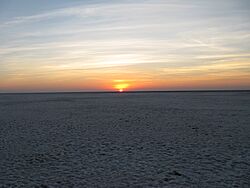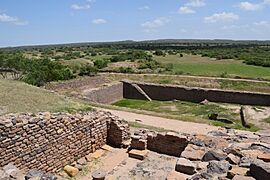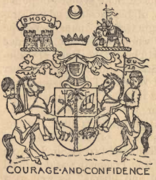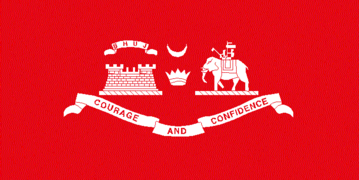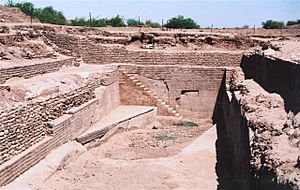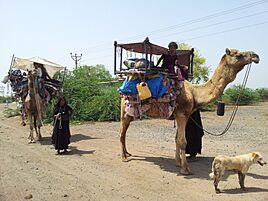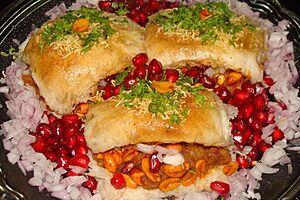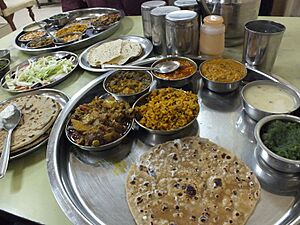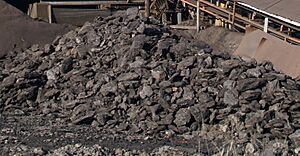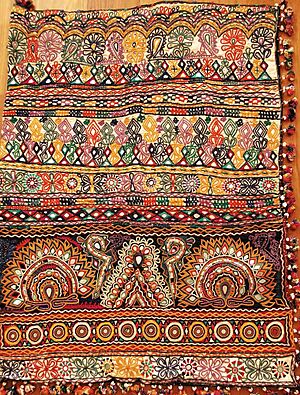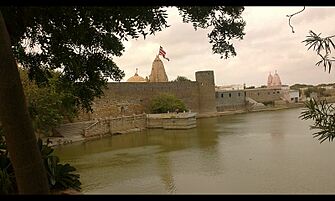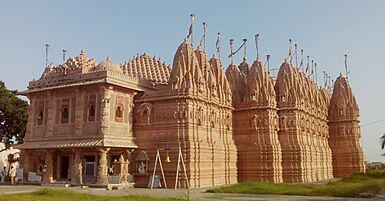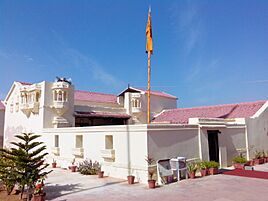Kutch district facts for kids
Quick facts for kids
Kutch
|
|
|---|---|
|
District of Gujarat
|
|
| Kachchh | |
|
Clockwise from top-left: Prag Mahal, Sun Temple in Kotai, Mundra Port, Rann of Kutch, Dholavira
|
|
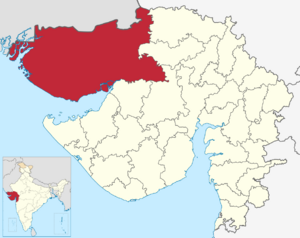
Location of Kutch district in Gujarat
|
|
| Country | |
| State | Gujarat |
| Headquarters | Bhuj |
| Tehsils | 10 |
| Area | |
| • Total | 45,674 km2 (17,635 sq mi) |
| Population
(2011)
|
|
| • Total | 2,092,371 |
| • Density | 45.8110/km2 (118.6499/sq mi) |
| Demographics | |
| • Literacy | 70.59 |
| • Sex ratio | 908 |
| • Language | |
| Time zone | UTC+05:30 (Indian Standard Time) |
| Vehicle registration | GJ-12 |
| Major highways | 1 |
| Official name: Dholavira: A Harappan City | |
| Type: | Cultural |
| Criteria: | Cultural: (iii)(iv) |
| Designated: | 2021 (44th session) |
| Reference #: | 1645 |
| Region: | Southern Asia |
Kutch district, officially spelled Kachchh, is a district of Gujarat state in western India, with its headquarters (capital) at Bhuj. Covering an area of 45,674 km2, it is the largest district of India. The area of Kutch is larger than the entire area of other Indian states like Haryana (44,212 km2) and Kerala (38,863 km2), as well as the country of Estonia (45,335 km2). The population of Kutch is about 2,092,371. It has 10 talukas, 939 villages and 6 municipalities. The Kutch district is home to the Kutchi people who speak the Kutchi language.
Kutch literally means something which intermittently becomes wet and dry; a large part of this district is known as Rann of Kutch which is shallow wetland which submerges in water during the rainy season and becomes dry during other seasons. The same word is also used in Sanskrit origin for a tortoise. The Rann is known for its marshy salt flats which become snow white after the shallow water dries up each season before the monsoon rains.
The district is also known for ecologically important Banni grasslands with their seasonal marshy wetlands which form the outer belt of the Rann of Kutch.
Kutch is surrounded by the Gulf of Kutch and the Arabian Sea to the south and west, while the northern and eastern parts are surrounded by the Great and Little Rann (seasonal wetlands) of Kutch. It is also next to the border with Pakistan, a neighbouring country of India. When there were not many dams built on its rivers, the Rann of Kutch remained wetlands for a large part of the year. Even today, the region remains wet for a significant part of year. The district had a population of 2,092,371 as of 2011 census, of which 30% were urban. Motor vehicles registered in Kutch district have a registration number starting with GJ-12. The district is well connected by road, rail and air. There are four airports in the district: Naliya, Anjar, Mundra, and Bhuj. Bhuj and Anjar are well connected with Mumbai airport. Being a border district, Kutch has both an army and an air force base.
Contents
History
The history of Kutch can be traced back to prehistoric times. There are several sites related to the Indus valley civilization in the region, and it is mentioned in Hindu mythology. The region is also mentioned in Greek writings during the reign of Alexander the Great. For a time, it was ruled by Menander I of the Greco-Bactrian Kingdom, which was then overthrown by Indo-Scythians. The region was later ruled by the Maurya Empire and Sakas. In the first century CE, it was under the Western Satraps, followed by the Gupta Empire. By the fifth century, the Maitraka dynasty of Valabhi took over from which its close association with the ruling clans of Gujarat started.
Hieun Tsang refers to Kutch as Kiecha in his writings. In the seventh century, Kutch was being ruled by Charans, Kathis, and Chavdas. The Chavdas ruled the eastern and central parts by the seventh century, but Kutch came under the rule of the Chaulukya dynasty by the tenth century. After the fall of Chaulukya, the Vaghelas ruled the state. By the thirteenth century, the Vaghelas controlled the whole of Kutch and adopted a new dynastic identity, Jadeja.
For three centuries, Kutch was divided and ruled by three different branches of the Jadeja brothers. In the sixteenth century, Kutch was unified under one rule by Rao Khengarji I of these branches, and his direct descendants ruled for two centuries and had a good relationship with the Gujarat Sultanate and Mughals. One of his descendants, Rayadhan II, left three sons, of whom two died, and a third son, Pragmalji I took over the state and founded the current lineage of rulers at the start of the seventeenth century. The descendants of the other brothers founded states in Kathiawar. After turbulent periods and battles with the armies of Sindh, the state was stabilized in the middle of the eighteenth century by a council known as Bar Bhayat ni Jamat who placed Rao as a titular head and ruled independently. The state accepted the sovereignty of the British East India Company in 1819, when Kutch was defeated in battle. That same year, the state was devastated by an earthquake. The state stabilized and flourished in business under subsequent rulers.
Upon the independence of India in 1947, Kutch acceded unto the dominion of India and was constituted an independent commissionaire. It was made a state within the union of India in 1950. The state witnessed an earthquake in 1956. On 1 November 1956, Kutch State was merged with Bombay state, which in 1960 was divided into the new linguistic states of Gujarat and Maharashtra, with Kutch becoming part of Gujarat as Kutch district. The district was affected by a tropical cyclone in 1998 and the earthquake in 2001. The state saw rapid industrialization and growth in tourism in subsequent years.
-
Dholavira, one of the largest cities of the Indus Valley Civilisation, with stepwell steps to reach the water level in artificially constructed reservoirs.
-
Ten Indus characters from the northern gate of Dholavira, dubbed the Dholavira Signboard.
Rivers and dams
There are ninety-seven small rivers in Kutch District, most of which flow into the Arabian Sea, but some of which feed the Rann of Kutch. Twenty major dams, and numerous smaller dams, capture the rainy season runoff. While most of these dams do not affect the Ranns, storage of rainy season water upstream from Kutch and its use in irrigation has resulted in less fresh water coming into the Ranns of Kutch during the rainy season. Water remains a serious issue in Kutch. Kutch's thirst for water is satisfied by Narmada river flowing from Sardar Sarovar dam.
Wildlife sanctuaries and reserves
From the city Bhuj various ecologically rich and wildlife conservation areas of the Kutch district can be visited such as Indian Wild Ass Sanctuary, Kutch Desert Wildlife Sanctuary, Narayan Sarovar Sanctuary, Kutch Bustard Sanctuary, Banni Grasslands Reserve and Chari-Dhand Wetland Conservation Reserve.
Culture
People
Kutch district is inhabited by various groups and communities. One can find various nomadic, semi nomadic and artisan groups living in Kutch. Rabari constitute a comparatively large group in Kutch And there lives a brave and noble community like Ahir.
Food and drink
Because most of the population of the Kutch district is Hindu or Jain, the food of the region is largely vegetarian. Jains also refrain from eating root vegetables (kandmool in Hindi) such as potatoes, garlic, onions, and yams. The district also features a sizeable population of Muslims, who eat vegetables, chicken, mutton and occasionally camel meat.
In the villages of the district, staple foods include kadi-khichdi, milk, and bajra (pearl millet). The latter of these was introduced to the region by a king named Lakho Fulani, who was himself introduced to the grain during his period of exile. Bajara na rotla with curd and buttermilk is also a staple among the Gujarati people.
In the region, milk is considered to be a sacred food; an offering of milk is considered a gesture of friendship and welcoming, and dispute settlements invariably involve the parties offering milk to each other. Similarly, in Kutchi engagement ceremonies, the bride's family offers milk to the groom's family as a symbol of accepting their relationship. They also extensively drink buttermilk during lunch.
Tea is the most popular drink in this region.
Economy
Historically Kutch was always considered a backward region due to its location and submerged geography. The situation seemed to have worsened after the disastrous Kutch earthquake in 2001. But in the next decade, the economy took an almost miraculous jump start due to the intense efforts of the Gujarat government. Kutch today is a growing economic and industrial hub in one of India's fastest growing states – Gujarat. Its location on the far western edge of India has resulted in the commissioning of two major ports: Kandla and Mundra. These ports are closest to the Gulf of Arabia (and thus to Europe by sea). The hinterland of north-western India hosts more than 50% of India's population.
Quality of roads is good in Kutch. The large part of the growth of Kutch came after intense development by the state government as part of 2001 earthquake relief.
Due to the existence of two major ports i.e. Kandla and Mundra transportation as a business has thrived. Since historical times the people of Kutch have formed the backbone of trade between Gujarat mainland and Sindh. After the formation of Pakistan this trade stopped for good, but due to the inception of the Kandla port, trade boomed again. Kandla port is also in Kutch. It is considered Gateway to India's North. It is managed by the Kandla Port trust.
Mineral
Kutch is a mineral rich region with a very large reserve of Lignite, Bauxite, Gypsum and other minerals. Kutch received tax break for industries for 15 years after the major earthquake on 26 January 2001. Lignite is mined only by Gujarat Mineral Development Corporation (GMDC) at its two mines in Panandhro and Mata no Madh. The Panandaro mines has now been reserved for GEB and GMDC power plants and GMDC has stopped supplying other industries from there.
Cement and power
Kutch also houses cement plants Gujarat Anjan Cement Limited promoted by infrastructure conglomerate Anjan Group and Sanghi Industries Ltd's promoted by Sanghi Group. The companies are now planning to increase the capacity at Abdasa location from 3–9 million tons per annum. By 2015, the company plans to produce 20 million tons.
Forestry
Kutch district has a scanty forest cover. Hence there is negligible risk of illegal cutting of forests. This coupled with the adequate facilities available at Kandla port has helped establish the timber market. In 1987, "Kandla Timber Association" was formed in order to resolve the specific problems of timber importers and timber allied industries coming up during the period. The timber industry is growing at a faster pace with 300 saw mills working in Gandhidham-Kandla Complex.
Salt
The Little Rann of Kutch is known for its traditional salt production and various references mention this to be a 600-year-old activity. During the British period, this activity increased manifold. It was used to fund a substantial part of the military expenses of the British government.
Communities involved in salt production are mainly Chunvaliya Koli, Ahir and Miyana (Muslim), residing in 107 villages in the periphery of Lesser Rann of Kutch. These communities are traditionally known to have the skills of salt production and are known as 'Agariyas'. Water quality in 107 villages of Lesser Rann of Kutch is saline, thus agriculture is not an option. Hence salt production is the only livelihood option for Agariyas. As per the Salt Commission's report there are 45000 Agariyas working in the salt pans of Kutch. Out of the estimated total annual production of India of about 18 million tonnes, Gujarat contributes 75% – mainly from Kutch and other parts of Saurashtra.
Textile art
Kutch is one of the most prolific regions in India in the area of textile art. Kutch Embroidery is dense with motifs, and a variation with mirrors sewn into the embroidery is one of the signature arts of this region.
Within the category of Kutch embroidery there are several sub-categories as each tribe and sub-tribe produces a unique signature form of art.
Kutchi embroidery is an evolving expression of the craft and textile traditions of the Rabaris, a nomadic tribe in Gujarat. Kutch embroidery is unique in the sense that a net is woven on a cloth using thread. The net is then filled in using the same thread by intricate interlocking stitches. The patterns are usually built around geometric shapes. This embroidery follows its own traditional design logic and juxtaposition of colours and motifs. The Rohanas tribals of Kutch specialise in skirt work. The Sodhas use a geometric style for their embroidery. The Garacia Jats are experts in tiny embroidery on the yoke, which intermingles with red, orange, blue and green threads. The Dhanetah Jats love embroidering broad pear-shaped mirrors using orange, black, yellow and red in chain stitch.
Notable religious sites
- Narayan Sarovar Temple and Koteshwar Temple
- Ashapura Mata temple at Mata no Madh. The village is located about 100 km from Bhuj. Ashapura Mata is the household deity (Kuldevti) of former Jadeja rulers of Cutch State.
- The Swaminarayan Sampraday has a huge following in this Kutch region. Their main temple in this district is Shri Swaminarayan Mandir, Bhuj.
- The Muslims have a following in the Kutch region. Their main dargah-shrine in this district is Shah Zakariya Ali Akbar, Hajipir.
- Anjar city also has a Swaminarayan Mandir
- Lakhpat has religious significance for three of India's most populous religions.
- The temple of Gudthar Vara Shri Matiya Dev, a deity of the Maheshwari sect, is located in Kutch. Shri Matiya Dev is considered very revered in the Maheshwari sect.
- Siyot Caves
- Mundra
- Khetabapa, Vithon
Important Jain places of Pilgrimage are -
- Shri Bhadreshwar Jain Tirth Derasar
- Koday Jain tirth (72 Jinalaya Jain Temple here is the most famous)
- Vanki Mahavir Jain Temple, Vaanki, Gujarat 370425
- Kothara Shantinath Jain Tirth, Kothara, Abdasa Taluka
- Naliya Thirth Jain Derasar
- Jakhau Mahavirswami Sw. Jain Tirth
- Suthri Dhrutkallol Parshwanath Maha Tirth, Suthari
See also
 In Spanish: Distrito de Kutch para niños
In Spanish: Distrito de Kutch para niños






